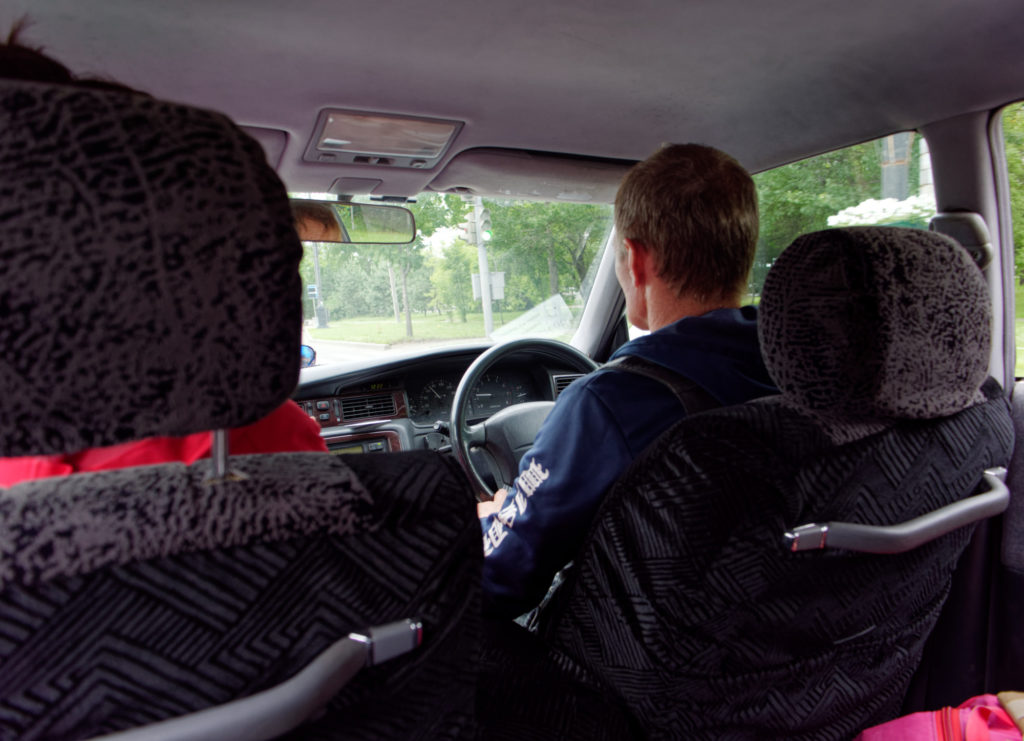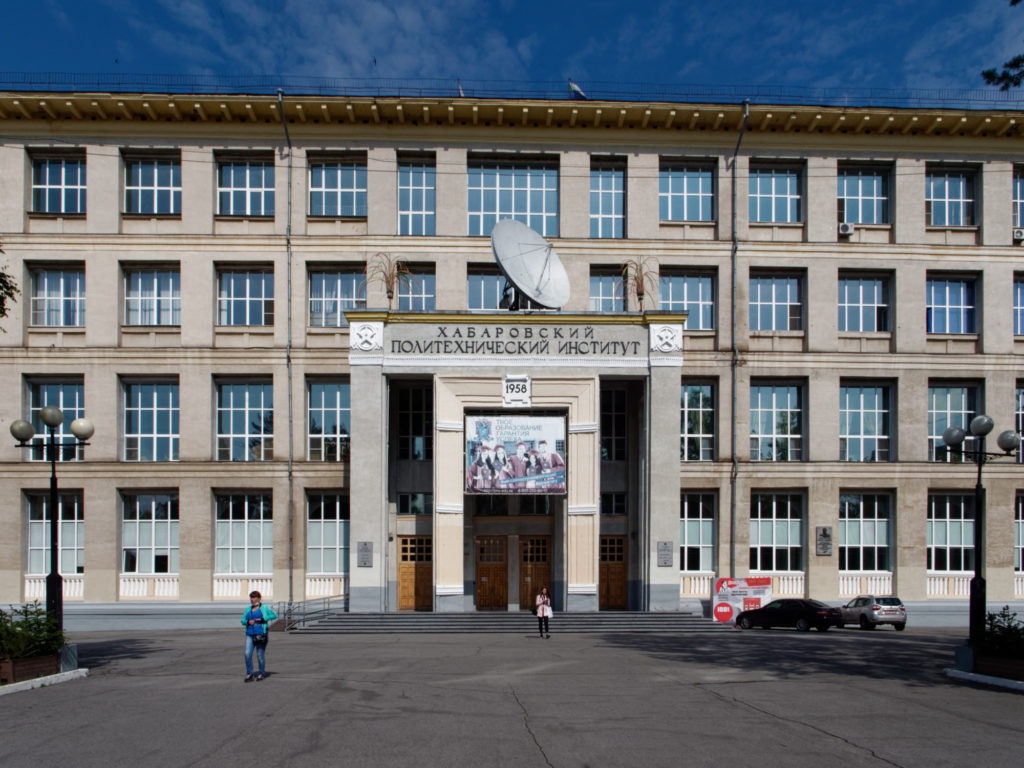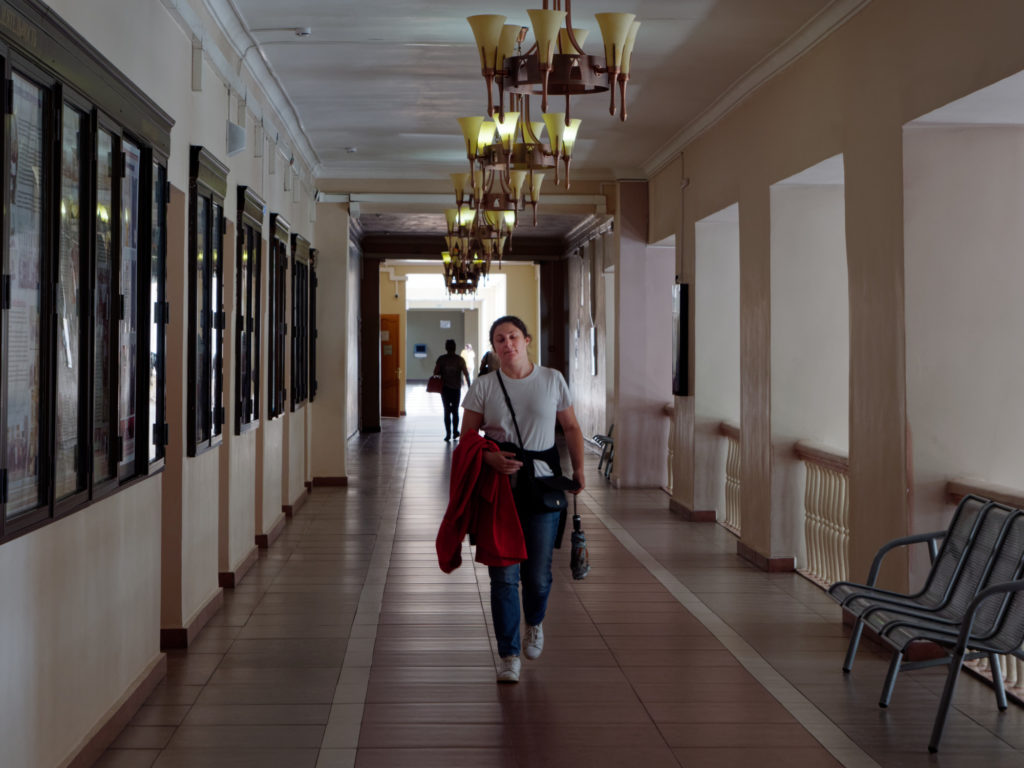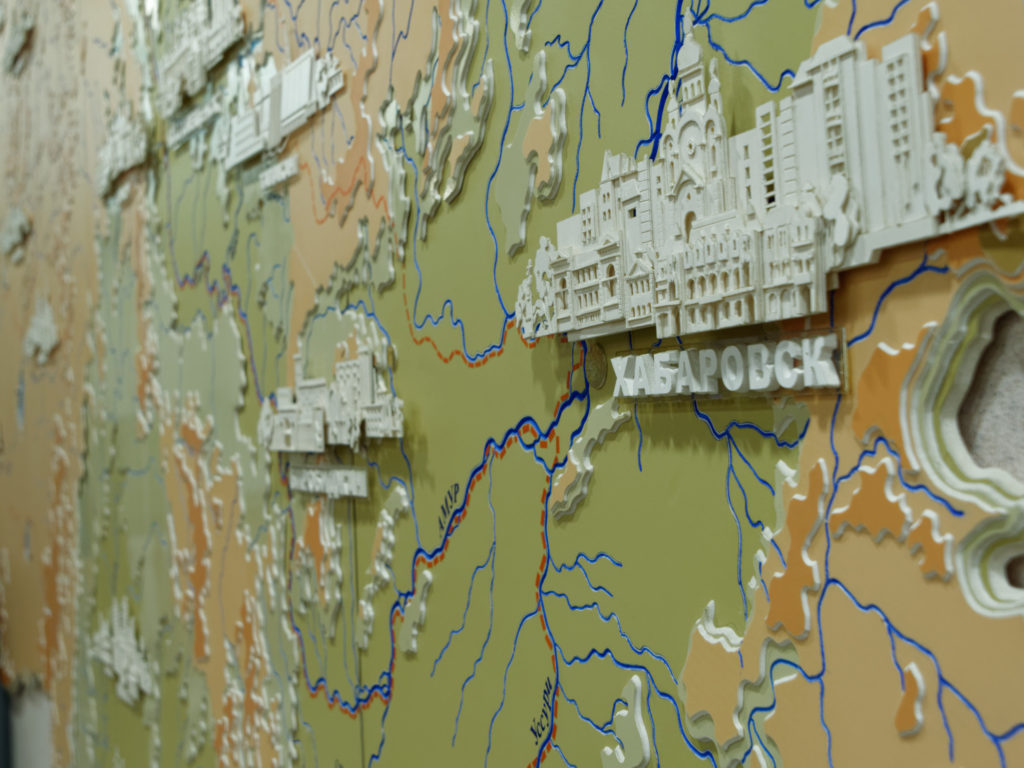Flying into tomorrow.
The night plane from Moscow to Khabarovsk. Distance to fly is over one fifth of the Earth circumference: Khabarovsk is five times closer to Tokyo than it is to Moscow. We leave at 21 pm, the flight lasts close to 8 hours. Arrival is scheduled at 11 AM in the morning, local time: we are flying into tomorrow.

In the plane, an old lady sitting next to me showed me a video of an ice tsunami on Amur this April. Grandiose blocks of ice pushed to the riverside bank of Khabarovsk by a river cracking open, breaking the steel fencing as if it were made from cardboard. The strengths of a wild animal and of a human meet on the same scale. The 4444 km Far East river laughs off any comparison to anything human.
Welcome to Khabarovsk!
The plane landed. Maria is already waiting for us. She has a yellow mask covering half of her face but her eyes are smiling. Such a contrast with other faces in the arrival hall of the airport. Serious expressions, sealed lips. Maria is one of the few people wearing a mask here.

A driver of the Mathematical Institute picks us up, his seat is on the right: Japanese cars are cheaper here. In the car, Maria warns us — it’s midges season. These are annoying small flies will try to bite you or get into your eyes. Some Khabarovsk inhabitants buy sprays, some spread diluted vanilla powder on their face, some play hard-core and ignore the midges, as our driver, she says.
The Big Fish.
Morning of the 2nd July, our first full day in Khabarovsk. Maria organized for us an excursion to the Grodekov’s Museum of Khabarovsk local history. The first floor of the museum is dedicated to installations of Amur’s bassin landscapes. They are filled with stuffed and sculpted representations of truly magical animals that live nearby, and in Amur River. The most famous is arguably a kaluga fish. Represented right after its adolescence, it is already bigger than a stuffed brown bear humbly staring at it from the next showcase. Some kalugas reach 1 ton but normal size in adult age is only 600 kg (1300 pounds), says our guide, a small woman with a wooden pointer. She cites the archives and recent research on wild kabarga dears (white ones were recently discovered!). She is of that calibre of museum guides, those who never give the same tour twice. A wooden pointer in her hands resembles a magic wand.
Khabarovsk Kray is the name of the Far East region of Russia. Its end point touches China, its right side opens to the Sea of Okhotsk, right to the Pacific Ocean, and it’s top point has the same longitude as Kamchatka. Area-wise, it is like Turkey. Nature of the Kray connects North and South — furs and shells are grey and brown , some are yellow or bright orange. In the Amur River fish from the North meets tropical fish from the South. Chinese Turtles with bright red ears climb up the rivers to come here. I ask Maria if she had a possibility to travel around in the East. Only South Korea, for the International Mathematical Congress in 2014. It’s hard to follow conferences with Khabarovsk English, she laughs. That’s how we call the absence of English here. She dreams to go to Japan but hasn’t found time yet.
Humbly dressed.
After lunch, we head to the North of Khabarovsk, to the old building of Polytechnical Institute, now part of the Pacific Ocean State University. Khabarovsk is 700 km away from the ocean, the secret of the name is in the address of the university! Pacific Ocean Street, 136. Such a possibility for jokes, smiles Maria, the university is named after a street, not the Ocean.

We meet with the members of the Far East Mathematical Center. A head of the seminar, Ellina Vikhtenko, pours us tea and serves the biscuits on the table. She never stops smiling. The director of the Mathematical Center, Evgeny Nurminsky, presents it to us. The Center is called MatIss (Matematicheskie Issledovania is Mathematical Research) and unites researchers from three Siberian laboratories: Vladivostok, Khabarovsk and Yakutsk, working on mathematical physics, computational mathematics, algebra and optimisation. The famous Matisse’s Dance is an informal logo of the center for three reasons: first, it’s a collective circle that symbolises different domains of math and different universities working together, second, it’s painted in three colors representing an RGB-model and modern numerical reality, and, finally, the dancers are dressed very humbly which is quite a symbol of the level of financing. The director smiles and rubs his hands. He is particularly proud of his last argument.

This year the financing has been doubled for the Center. Maria remarks that she is surprised that it happened provided that the “three reasons for MatIss” are written on the official Center’s webpage. She asks Evgeny if there is some work done by the Center with school children in Vladivostok. Some work is done, he says. A city math club? No, but some researchers give private math lessons.
Not a saint.
Maria is arguably the most active olympiad teacher in Khabarovsk. She organizes problem-solving sessions with groups of children interested in mathematics, starting from 10 years old. Since the last year, the new Mathematical Center pays her and her five other colleagues for these activities. 1000 rubles (11 EUR) per academic hour (45 minutes) is a very good salary, she says.

I am ready to work in any conditions. My collective permits me not to sacrifice anything, people are ready to support me now. You have first to start doing things you love, and then somebody will notice what you do and want to pay you for it, not another way around.”
The financing for the Mathematical Center is offered for four years. It won’t last forever and Maria is ready for it. She will continue to strengthen the Olympiad movement in Khabarovsk anyway. I ask her if she ever paid things from her own pocket for the math club. Does it matter?, she asks. It is easier for me, she says, I don’t like to beg, and it’s easier to do things yourself than to hope for the bureaucracy to give you the money. Several years before, she was bringing dozens of books from Moscow for children in her math club. It brings lots of joy to them, and it is important to read math, she says.
One friend once said to me, Maria, you are telling all of it as if you were a saint. But if I really were a saint, I wouldn’t tell it to anybody!, she laughs.
When Maria started her activity, she was paid only 600 RUB an academic hour and had trouble to find people that would want to teach olympiad problems to school children with her. How to attract people? The only way, she says, is to share the money 1:1. Each of us got 300 RUB per hour, that’s how I have found help at the start. Then, people take taste in teaching math to children and do not want to stop. A colleague of mine, a brilliant Moscow mathematician who came to work in Khabarovsk, first wanted to do only research and didn’t want to teach at all. He also found the children very slow. I promised him that I will prepare them from the 5th grade, and by the 8th grade (13 years) they will be ready for doing math with him. In 5 years that he has been here, he changed a lot. Teaching matters to him now and he doesn’t only want to do research anymore.






Quel foisonnement d activités !
Et tout ça, dans un dévouement et une grande humilité !
Bravo à toutes ces personnes que vous mettez ,tous les deux,en 1ere ligne ! Elles le méritent !